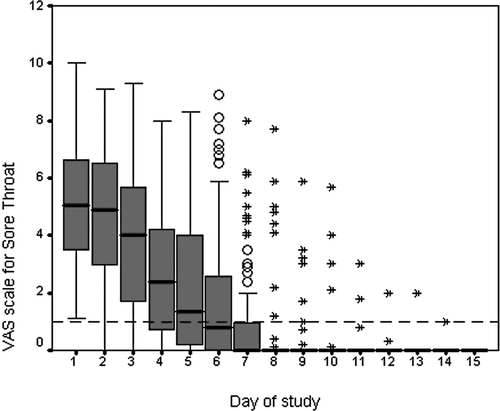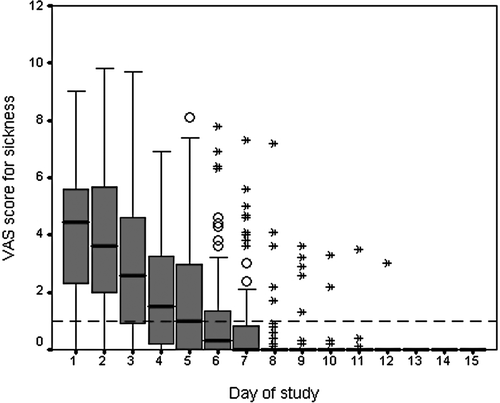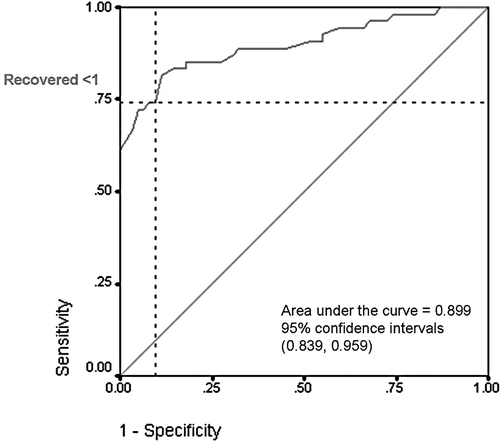Abstract
Objective. To evaluate the natural clinical course of suspected viral sore throat. Design. Prospective cohort study. Setting. Five military camps in Norway. Methods. In a randomized placebo-controlled trial comparing the effect of bovine colostrum tablets or placebo on non-streptococcal sore throat in young adults no statistically significant difference in illness duration was found. The participants were thus regarded as one cohort. The authors analysed 10.0 cm visual analogue scales (VAS) scores for ‘sickness’ and sore throat, using 1.0 cm as a cut-off for recovery. They furthermore explored whether the VAS for sore throat was a good test to discriminate between recovered/not recovered by use of a receiver operating characteristic (ROC) curve. Results. For sore throat, it was found that 51% had recovered by day 6 and 91% had recovered by day 8. Similarly for sickness, 65% had recovered by day 6 and 94% by day 8. The daily VAS scores for ‘sickness’ and sore throat were highly correlated (p = 0.001). The mean day of recovery from ‘sickness’ and sore throats (based on VAS scores) was 5.5 and 4.7 respectively and 5.3 based on the dichotomous outcome for throat pain. The ROC curve revealed that a VAS score < 1.0 was the best cut-off point for recovery, with a sensitivity of 0.74 and a specificity of 0.90. Conclusion. Almost all the patients had recovered by day 8. A high correlation was found between sickness and sore throat. These data will assist clinicians and others promoting self-care to set realistic expectations regarding recovery from URTI in young adults.
Acute viral upper respiratory tract infection (URTI) is a common condition in the general population with an estimated annual incidence of 6–8 episodes among children and 2–3 among adults Citation[1]. It is usually a self-limiting disease, but long duration (as well as a range of other triggers) may lead to consultation. Sore throat is commonly prominent in URTI. The clinical course of URTI has been described in few studies Citation[2–4]. Such data are important in that it would help clinicians set realistic expectations with patients about illness duration. A study of children with URTI demonstrated that one quarter of the children had not recovered seven days after consulting Citation[5].
We previously conducted a randomized placebo-controlled trial comparing the effect of bovine colostrum tablets or placebo on sore throat in young adults Citation[6]. Since the clinical course was similar in all three groups, and no notable or statistically significant difference in illness duration between the treatment groups was found, we were able to consider the participants as one cohort to evaluate the natural clinical course of suspected viral sore throat in URTI.
Acute viral upper respiratory tract infection (URTI) with non-streptococcal sore throat is a common condition in the general practice population.
Some 51% of the patients had recovered by day 6 and 91% by day 8.
We found a high correlation between sore throat and sickness as stated on a VAS scale.
The purpose of this study was to measure the duration and strength of symptoms in patients with a suspected viral sore throat. We also aimed to contribute to research methods in this area by exploring the relationship between visual analogue scales (VAS) scores for ‘sickness’ and sore throat, and to explore whether the VAS for sore throat was a good test to discriminate between recovered/not recovered by use of a receiver operating characteristic (ROC) curve.
Material and methods
The study was carried out in patients with suspected, acute (less than one week), viral sore throats in five military camps in Norway during the winters of 1999–2001. Those with a positive Group A Streptococcal (GAS) antigen detection test were excluded The test used had a sensitivity of 0.97 and a specificity of 0.95 Citation[7].
The participants recorded the following information daily until they felt well to a maximum of 15 days: their throat pain and ‘sickness’ on a VAS (0–10.0cm) with a higher score indicating greater pain or ‘sickness’, and the following 8 dichotomous (yes/no) questions: cough, rhinorrhoea, nasal congestion, headache, hoarseness, subjective fever, sick-leave taken, and throat pain Citation[8].
Missing data
For the sore throat data based on the VAS, 5 participants had missing values for day 1, and another 5 had missing values for other days, mostly for one day. For the ‘sickness’ data, 4 participants had missing values for day 1, and another 6 had missing values for other days. For participants with missing values for day 1, we estimated values using regression, but only if a linear trend was evident in the VAS scores for subsequent days. Missing values for other days were estimated by taking the mean score for the days on either side.
Some subjects had a final VAS score ≥1.0 and it was therefore impossible to determine whether they had recovered or simply stopped recording the information. Therefore all subsequent days in these individuals were classified as missing, and were excluded from the analysis from that day on.
Analysis
The natural history of suspected viral sore throat was illustrated using box and whisker plots, to show the daily median VAS score along with the inter-quartile range. Box and whisker plots are presented for VAS ratings of both sore throat and general ‘sickness’.
For each day (for sore throats and ‘sickness’ VAS scores) a subject was classified as:
recovered – having a VAS score < 1.0 on that day and for subsequent days, or
not recovered – either (a) having a score of ≥ 1.0 on that day or (b) having a score < 1 with a subsequent value being ≥ 1.0.
The percentage of subjects recovering was calculated daily for both sore throats and ‘sickness’ (based on VAS score) and also for throat pain (dichotomous). The day that the subject recovered was also recorded for both VAS scores on sore throat and ‘sickness’ and also for the dichotomous score for throat pain. Associations between (a) the daily VAS scores for sore throat and ‘sickness’, (b) the day of recovery from sore throat and ‘sickness’ (based on the VAS), and (c) the day of recovery for sore throat and throat pain (dichotomous), were examined using Pearson's and Spearman's correlation coefficients.
A receiver operating characteristic (ROC) curve was produced using the dichotomous sore throat question as the ‘reference standard’. The area under the curve was calculated to determine whether the VAS score for sore throat was a good test to discriminate between those recovering from a sore throat and those not recovering, and we assessed whether the cut-off point of < 1.0 used for recovery was the best cut-off point. To ensure approximately equal numbers in each group of the dichotomous variable, data from day 5 were taken (recovered n = 54, not recovered n = 62).
Results
A total of 148 participants were recruited. The median age was 20 (inter-quartile range 19 to 21) and 94% (139) of the participants were male. A total of 59% (88) and 63% (93) of participants completed the diary until they had recovered (based on the VAS scores for sore throat and ‘sickness’ respectively). The remainder discontinued filling in the diary before our definition of recovery. There were no differences between these two sub-groups with respect to age, gender, and VAS score for sore throat on day 1. However, a significant difference was found with regard to their VAS ‘sickness’ score on day 1 (t = 4.392, p < 0.001). Those discontinuing the diary before recovering were sicker (mean = 4.9) than those completing the diary until recovery (mean = 3.5).
Daily median scores for sore throat and ‘sickness’ followed a similar pattern with the median score falling below 1.0 (recovered) on day 6 for both outcomes (see and ). The figures also demonstrate the number of outliers and extremes on each day. For sore throat, we found that 51% had recovered by day 6 and 91% had recovered by day 8 (). Similarly for sickness, 65% had recovered by day 6 and 94% by day 8 ().
Figure 1. Duration of sore throat over 15 days in adult patients with sore throat in 5 Norwegian military camps during winters 1999–2001. Whiskers show largest and smallest non-outlying values: Circles show patients that are more than 1.5 inter-quartile ranges from the 25th or 75th centiles (outliers); asterisks show patients more than 3 inter-quartile ranges from the 25th or 75th centiles (extremes); broken line shows score of 1 (recovered).

Figure 2. Duration of sickness over 15 days in adult patients with sore throat in 5 Norwegian military camps during winters 1999–2001. Whiskers show largest and smallest non-outlying values: Circles show patients that are more than 1.5 interquartile ranges from the 25th or 75th centiles (outliers); asterisks show patients more than 3 inter-quartile ranges from the 25th or 75th centiles (extremes); broken line shows score of 1 (recovered).

Table I. Proportion recovering from sore throat (VAS), sickness (VAS), and sore throat (dichotomous) given as percentages and n/total for sore throat patients in Norwegian military camps.
The daily VAS scores for ‘sickness’ and sore throat were highly correlated (all p = 0.001). The mean day of recovery from ‘sickness’ and sore throats (based on VAS scores) was 5.5 and 4.7 respectively and 5.3 based on the dichotomous outcome for throat pain. The actual day that a subject recovered from ‘sickness’ and sore throat based on VAS scores was highly correlated (r = 0.416, p < 0.001), as was the day that a subject recovered from a sore throat (based on VAS score < 1.0) and throat pain (response = no) (r = 0.830, p < 0.001).
The ROC curve for sore throat is shown in . A VAS score < 1.0 was found to be the best cut-off point for recovery, with a sensitivity of 0.74 and a specificity of 0.90. The area under the curve was 0.90 with a 95% confidence interval of (0.84, 0.96).
Discussion
Clinically useful information
Our study provides useful information about the natural course of a suspected viral, non-streptococcal sore throat in younger adults, which is a common condition in the general population and is often dealt with without consulting a doctorCitation[1], Citation[4], Citation[9]. These data will assist clinicians and others promoting self-care to set realistic expectations regarding recovery from URTI in young adults. The mean duration of illness was between 5 and 6 days. By day 8, 9 out of 10 patients recovered, although some still felt sick after 10–12 days. Butler et al. described the clinical course for children consulting in general practice with suspected acute viral upper respiratory tract infection, and found that more than half of the children had recovered 5 days after consulting Citation[5]. We are not aware of comparable data for adults, but the duration of symptoms is in line with Zwart's findings in patients with streptococcal tonsillitis Citation[10]. Clinical recommendations are united in promoting the cautious use of antibiotics for treating sore throats Citation[11–13].
Contribution to research methods
The results from the VAS to measure global “sickness” and specifically sore throat show that the two outcomes are closely associated with each other, as is the day of recovery from sore throat determined by the VAS and the dichotomous variable. Thus, only one VAS to record daily “sickness” or a “yes/no” question about the presence of throat pain to determine the day of recovery could probably be used in future research, thus reducing respondent burden. This may also improve response rates in research studies. For sore throat, a VAS score < 1.0 appears to be the best cut-off point for recovery.
Limitations
Approximately 60% of respondents continued recording their symptoms in the diary until they met our definitions of recovery from sore throat and “sickness”. There was a high dropout rate between days 1 and 2 and days 7 and 8 (see ). While no notable differences were found between completers and non-completers with regard to age, gender, and sore throat VAS scores on day 1, the non-completers were sicker on day 1.
The applicability of these data are limited as the study included only young adults (military recruits), most of whom were male. Nevertheless, this secondary analysis of trial data has provided clinically useful information regarding the clinical course of this common illness, which may help people plan self-care and help clinicians set evidence-based expectations among young adults with URTI. In addition, we have made suggestions regarding outcome measurement that may be useful for others researching this common condition.
References
- Dingle J, Badger G, WS J. Illnesses in a group of Cleveland families. Western Reserve University, Cleveland, OH 1964
- Little P, Gould C, Williamson I, Warner G, Gantley M, Kinmonth AL. Clinical and psychosocial predictors of illness duration from randomised controlled trial of prescribing strategies for sore throat. BMJ 1999; 319: 736–7
- Shvartzman P, Lieberman D, Tandeter H, Portugeiz E, Pshetizky Y, Sasson M, et al. Clinical and laboratory profile of febrile respiratory infections in general practice. J Am Board Fam Pract 2004; 17: 32–7
- Andre M, Odenholt I, Schwan A, Axelsson I, Eriksson M, Hoffman M, et al. Upper respiratory tract infections in general practice: Diagnosis, antibiotic prescribing, duration of symptoms and use of diagnostic tests. Scand J Infect Dis 2002; 34: 880–6
- Butler CC, Kinnersley P, Hood K, Robling M, Prout H, Rollnick S, et al. Clinical course of acute infection of the upper respiratory tract in children: Cohort study. BMJ 2003; 327: 1088–9
- Lindbaek M, Thom E, Fuglerud P, Hjortdahl P. [Do colostrum tablets have a symptomatic effect on sore throat?]. Tidsskr Nor Laegeforen 2004; 124: 3187–90
- Lindbaek M, Høiby EA, Lermark G, Steinsholt IM, Hjortdahl P. Which is the best method to trace group A streptococci in sore throat patients: Culture or GAS antigen test?. Scand J Prim Health Care 2004; 22: 233–8
- Kiderman A, Yaphe J, Bregman J, Zemel T, Furst AL. Adjuvant prednisone therapy in pharyngitis: A randomised controlled trial from general practice. Br J Gen Pract 2005; 55: 218–21
- Schwartz B, Giebink GS, Henderson FW, Reichler MR, Jereb J, Collet JP. Respiratory infections in day care. Pediatrics 1994; 94: 1018–20
- Zwart S, Sachs AP, Ruijs GJ, Gubbels JW, Hoes AW, de Melker RA. Penicillin for acute sore throat: Randomised double blind trial of seven days versus three days treatment or placebo in adults. BMJ 2000; 320: 150–4
- Del Mar CB, Glasziou PP, Spinks AB. Antibiotics for sore throat. The Cochrane Database of Systematic Reviews 2004, (2).
- Molstad S. Reduction in antibiotic prescribing for respiratory tract infections is needed!. Scand J Prim Health Care 2003; 21: 196–8
- Christiaens T, De Backer D, Burgers J, Baerheim A. Guidelines, evidence, and cultural factors. Scand J Prim Health Care 2004; 22: 141–5
